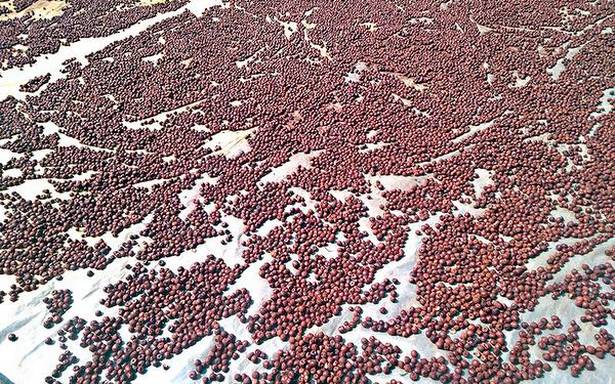A kilo of red arecanut is being sold at ₹545
Arecanut growers have reason to cheer with prices going up and growers who have stock getting good money. Farmers, who are yet to harvest the yield, are hopeful that the current prices will continue for a few more days.
As per the latest reports, a kilo of red arecanut is being sold for as high as ₹545. The average price was around ₹530. Similarly, the price of old white arecanut went up to ₹505 per kg and fresh arecanut at ₹460 a kg. This trend is leading growers to recall the days of 2014, when a quintal of arecanut was valued at ₹90,000.
“The arrival of fresh red arecanut has begun, hence the price which had gone up to ₹600 a kg, came down recently,” said Jaya Bhandari, who works with Central Arecanut and Cocoa Marketing and Processing Cooperative Ltd. (CAMPCO).
People who have been following the arecanut market opine that the price has been going up because of increase in demand. “There is no stock of arecanut in north India. Growers and traders who have stock are making profits,” said Bhandari.
Growers get around eight to 10 quintals of arecanut per acre. Those with even two or three acres of plantations could earn a considerable sum, given the prevailing rates. But, small growers have hardly benefited as they had sold their stock long ago.
Rich farmers benefit
As many parts of arecanut growing areas in Karnataka continued to receive rain, harvest was delayed, contributing to increase in price.
“We sell the yield soon after harvest. This time, we will earn well provided the current prices continue till we harvest,” said Chandrashekar, a grower at Holehonnur.
The plight of areca growers in parts of Sringeri and Tirthahalli is different. The yield in the plantations has fallen drastically over the years due to yellow leaf disease. Some planters get yield as low as a few kilos per acre. “The price rise does not benefit us. We are fighting against yellow leaf disease to protect our plantations,” said Srinivasamurthy, who has a plantation near Sringeri.
He also opined that an abnormal increase in price would cause social problems. “It will widen the gap between big and small growers,” he said.
Source: Read Full Article

